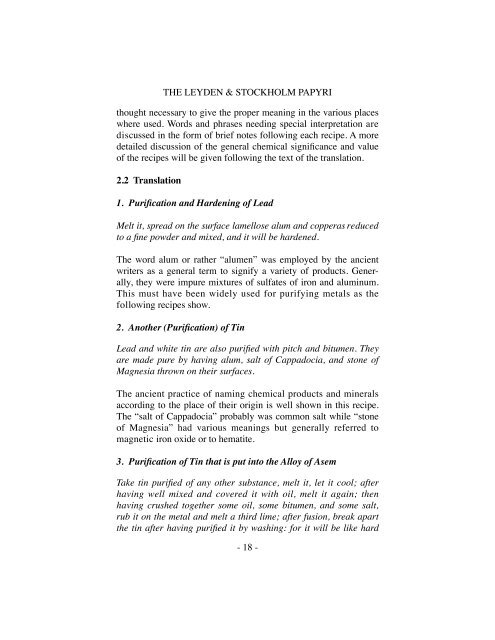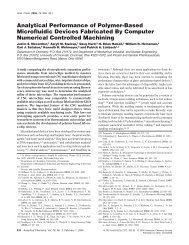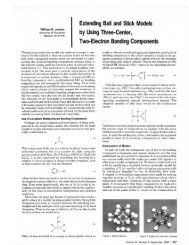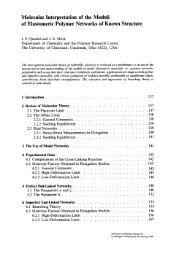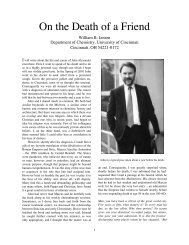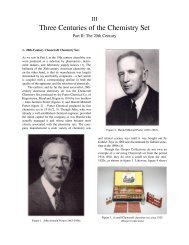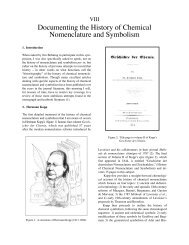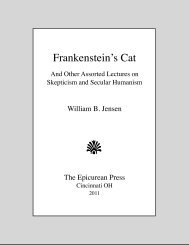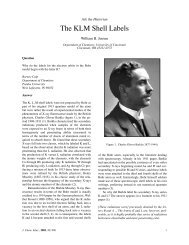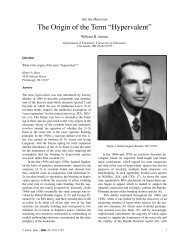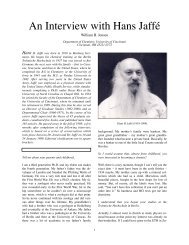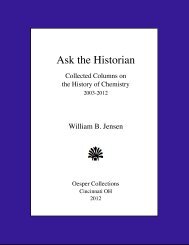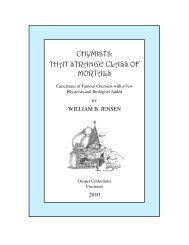The Leyden and Stockholm Papyri - University of Cincinnati
The Leyden and Stockholm Papyri - University of Cincinnati
The Leyden and Stockholm Papyri - University of Cincinnati
Create successful ePaper yourself
Turn your PDF publications into a flip-book with our unique Google optimized e-Paper software.
thought necessary to give the proper meaning in the various places<br />
where used. Words <strong>and</strong> phrases needing special interpretation are<br />
discussed in the form <strong>of</strong> brief notes following each recipe. A more<br />
detailed discussion <strong>of</strong> the general chemical significance <strong>and</strong> value<br />
<strong>of</strong> the recipes will be given following the text <strong>of</strong> the translation.<br />
2.2 Translation<br />
THE LEYDEN & STOCKHOLM PAPYRI<br />
1. Purification <strong>and</strong> Hardening <strong>of</strong> Lead<br />
Melt it, spread on the surface lamellose alum <strong>and</strong> copperas reduced<br />
to a fine powder <strong>and</strong> mixed, <strong>and</strong> it will be hardened.<br />
<strong>The</strong> word alum or rather “alumen” was employed by the ancient<br />
writers as a general term to signify a variety <strong>of</strong> products. Generally,<br />
they were impure mixtures <strong>of</strong> sulfates <strong>of</strong> iron <strong>and</strong> aluminum.<br />
This must have been widely used for purifying metals as the<br />
following recipes show.<br />
2. Another (Purification) <strong>of</strong> Tin<br />
Lead <strong>and</strong> white tin are also purified with pitch <strong>and</strong> bitumen. <strong>The</strong>y<br />
are made pure by having alum, salt <strong>of</strong> Cappadocia, <strong>and</strong> stone <strong>of</strong><br />
Magnesia thrown on their surfaces.<br />
<strong>The</strong> ancient practice <strong>of</strong> naming chemical products <strong>and</strong> minerals<br />
according to the place <strong>of</strong> their origin is well shown in this recipe.<br />
<strong>The</strong> “salt <strong>of</strong> Cappadocia” probably was common salt while “stone<br />
<strong>of</strong> Magnesia” had various meanings but generally referred to<br />
magnetic iron oxide or to hematite.<br />
3. Purification <strong>of</strong> Tin that is put into the Alloy <strong>of</strong> Asem<br />
Take tin purified <strong>of</strong> any other substance, melt it, let it cool; after<br />
having well mixed <strong>and</strong> covered it with oil, melt it again; then<br />
having crushed together some oil, some bitumen, <strong>and</strong> some salt,<br />
rub it on the metal <strong>and</strong> melt a third lime; after fusion, break apart<br />
the tin after having purified it by washing: for it will be like hard<br />
- 18 -


